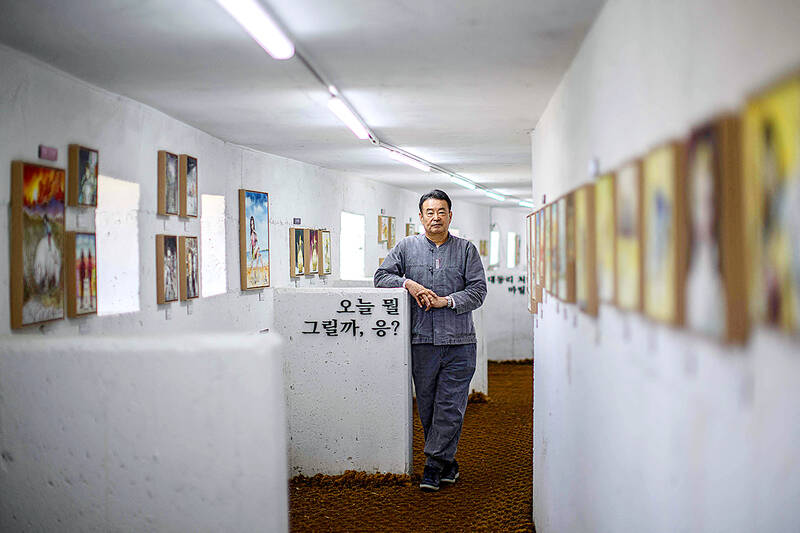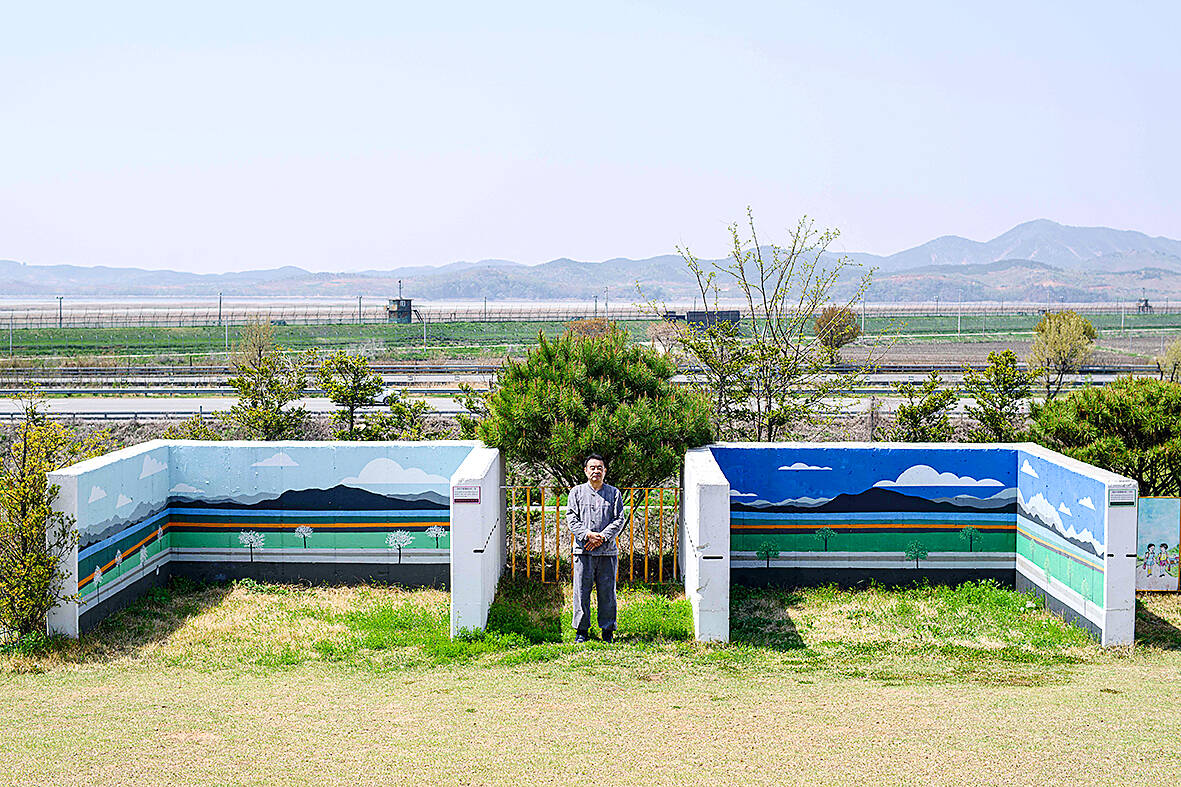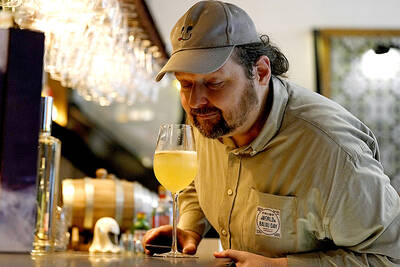Reclining on sofas at a South Korean cafe, customers sip iced americanos as they gaze past barbed wire fences and watchtowers at the mountains of North Korea.
Daonsoop cafe is so close to the North Korean border that to obtain the building permit, its owners had to construct the property with a bunker and fortified positions for tanks.
Founder Lee Oh-sook and her husband, both the children of North Korean refugees, built the cafe less than two kilometers from the border in Paju, seeking proximity to their ancestral homeland.

Photo: AFP
“From here, you can see North Korea, so close but inaccessible... Our parents always hoped to return to their homeland, but they died before realizing this dream,” 63-year-old Lee said.
“We chose to settle here to think of them more often.”
The two countries are technically still at war as the 1950-1953 conflict ended in an armistice rather than a peace treaty, and South Korea still refers to the border as the “front line.”

Photo: AFP
Below the cafe’s bay windows runs the Jayu-ro motorway, or “Freedom Road,” which in an ideal future would link Seoul to Pyongyang, but currently stops at the Reunification Bridge near the border.
The Imjin river, which separates the two Koreas, runs alongside the motorway, while a sign in a military-controlled border area warns that “trespassers may be treated as an enemy or suspect and shot.”
BUNKER ART GALLERY
Every night, giant loudspeakers across the border in North Korea broadcast blood-curdling sounds as part of a noise campaign emblematic of the two countries’ steadily declining ties.
The soundtrack of wolf howls, screams and ghostly creaks is so powerful it rattles the cafe’s windows.
Daonsoop is far from the only cafe with a view of the North: a Starbucks in an observatory on the border has itself become a tourist attraction.
But it is one of the closest by far, and it also has a bunker — requisitioned once a year by the South Korean army for military exercises.
The rest of the time, cartoonist and neighbor Kim Dae-nyeon uses the bunker to exhibit his artwork under his alias Danny Kim.
Hung between the bunker’s narrow loopholes overlooking the North, his drawings depict the pain of division and hopes for Korean reunification.
“This bunker is a space designed for combat, but I don’t see it that way. I see it as a place where freedom and peace begin,” Kim said.
In one drawing, an imagined bridge spans the Imjin river. Another shows weasels wearing noise-canceling headphones protesting the loudspeakers blasting from the North.
Outside, Kim has painted the walls of the tank yard in colors depicting the four seasons.
When life gets tough, “I come here to look at North Korea,” he said. “It makes me realize how relatively happy I am.”
Before his retirement, Kim was the head of South Korea’s National Election Commission. His 40-year career in the service of democracy, he says, has profoundly influenced his art.
NORMALIZED DIVISION
“I hope North Korea will also adopt democracy and freedom one day. My convictions about peace and freedom have continued first through my public career, and now in my artistic work,” he said.
The cafe also attracts North Koreans who have defected to the South. During family holidays such as Seollal (Lunar New Year) and Chuseok in the autumn, they can look across to their homeland from its terrace.
On the other side of the border, North Korean farmers go about their business, burning rice fields at the end of winter in a polluting agricultural practice eradicated in the South.
The pungent smoke billows across the border and envelops the cafe, but some customers, indifferent like many South Koreans to their northern neighbor, are unaware of the cause.
“It looks so calm and peaceful right now, but many visitors don’t know that the North is just across the road, so when they find out, they’re surprised,” Lee said.
“Most people forget that the country is divided and this reality is normalized.”

The unexpected collapse of the recall campaigns is being viewed through many lenses, most of them skewed and self-absorbed. The international media unsurprisingly focuses on what they perceive as the message that Taiwanese voters were sending in the failure of the mass recall, especially to China, the US and to friendly Western nations. This made some sense prior to early last month. One of the main arguments used by recall campaigners for recalling Chinese Nationalist Party (KMT) lawmakers was that they were too pro-China, and by extension not to be trusted with defending the nation. Also by extension, that argument could be

Aug. 4 to Aug. 10 When Coca-Cola finally pushed its way into Taiwan’s market in 1968, it allegedly vowed to wipe out its major domestic rival Hey Song within five years. But Hey Song, which began as a manual operation in a family cow shed in 1925, had proven its resilience, surviving numerous setbacks — including the loss of autonomy and nearly all its assets due to the Japanese colonial government’s wartime economic policy. By the 1960s, Hey Song had risen to the top of Taiwan’s beverage industry. This success was driven not only by president Chang Wen-chi’s

Last week, on the heels of the recall election that turned out so badly for Taiwan, came the news that US President Donald Trump had blocked the transit of President William Lai (賴清德) through the US on his way to Latin America. A few days later the international media reported that in June a scheduled visit by Minister of National Defense Wellington Koo (顧立雄) for high level meetings was canceled by the US after China’s President Xi Jinping (習近平) asked Trump to curb US engagement with Taiwan during a June phone call. The cancellation of Lai’s transit was a gaudy

The centuries-old fiery Chinese spirit baijiu (白酒), long associated with business dinners, is being reshaped to appeal to younger generations as its makers adapt to changing times. Mostly distilled from sorghum, the clear but pungent liquor contains as much as 60 percent alcohol. It’s the usual choice for toasts of gan bei (乾杯), the Chinese expression for bottoms up, and raucous drinking games. “If you like to drink spirits and you’ve never had baijiu, it’s kind of like eating noodles but you’ve never had spaghetti,” said Jim Boyce, a Canadian writer and wine expert who founded World Baijiu Day a decade